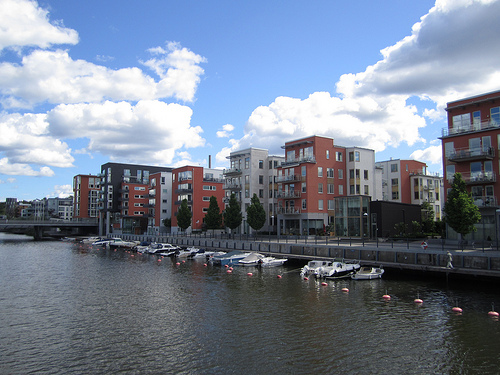The top 10 trends in sustainable urban development
Mobility, environmental protection, housing: Around the world, countries are aiming for sustainable urban development (SUD) that encompasses these, and more, vital segments of daily living. A new study, “Toward the sustainable development of urban areas: An overview of global trends in trials and policies,” from Abbas M. Hassan and Hyowon Lee, pinpoints what’s trending now in the fascinating field of sustainable urban development.

Stockholm, where even truck-owning coal miners are seemingly net carbon consumers. Image from La Citta Vita.
What is sustainable development, exactly? The researchers say the concept means “providing people with a better quality of life,” but it is also defined as a “dynamic process connecting local and global concerns, as well as linking local social, economic, and ecological issues, in order to fairly meet the needs of current and future generations.”
The aim of the study isn’t just to identify the hot-button issues facing SUD, but also to help land use experts make informed decisions. It addresses two important questions:
- What are the new findings worldwide in the field of SUD?
- Which topics have received significant international attention, especially in terms of land use policies?
The researchers studied the links between sustainable development and urban areas, and the related impact of this notable connection on land use policy.
The study pinpointed ten of the top trends in the field, in the researchers’ words:
- A balanced approach to SUD
- Socio-cultural awareness
- Urban sprawl
- Economic urban development
- Transportation
- Urban renewal
- Mitigating greenhouse gases (GHG)
- Urban vegetation
- Assessment systems
- City structure and land use
They chose these topics based on themes that emerged in publications over the last five or so years.
Some of the study’s most significant takeaways include:
- Asian countries, particularly China, are implementing SUD changes more rapidly than other countries.
- Connections between home and work are affording special opportunity for SUD growth.
- Transportation poses the greatest challenge in the field.
- Socio-cultural awareness — people pushing for changes — has become “a generator” for SUD.
The first of the themes, balance, is best exemplified by China, where sustainable development is rapidly on the rise, but harmony is lacking between different regions. Sustainable urban competitiveness, which means “an equilibrium in the progress between economic, social, and environmental aspects,” is at present “out of balance,” write the researchers. “While Shanghai is ahead regarding economic sustainability, Beijing leads the way in social competitiveness, and Zhuhai is foremost in terms of environmental sustainability.”
This imbalance means that, while one area is moving ahead with SUD, another area is picking up the slack and perhaps suffering as a result — even if it is excelling economically or socially. “Balanced SD in a specific city should not happen at the expense of adjacent ones; in other words, one city’s problems and local resources must not be shunted to a neighboring one.”
The researchers dive in, trend by trend, to uncover the trajectory of SUD and perhaps offer insight into its implications. Of particular note are the topical SUD issues different countries are most concerned with. For example, the U.S., U.K., Australia, France and Singapore raise the issue of transportation, with the researchers noting a “difference and imbalance between various cities’ ability to provide sustainable transport. London is an example of a city with good public, emergency, and smart transport.”
Romania raises the issue of urban renewal, while Sweden and Australia are particularly interested in mitigating GHG via waste management. These trends are changing, and are often intricately related to each other. As the researchers phrase it, “the approaches to SUD are multiple and complex, the relevant issues are intertwined, and it is hard to separate them from each other.” Learn more from the full report, available here.
Related Posts
Category: Infrastructure, Miscellaneous

















